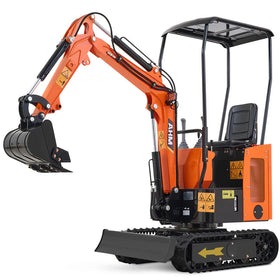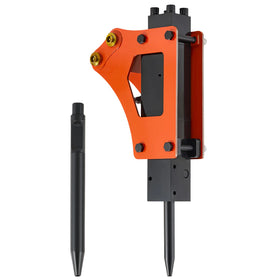So, you are looking to buy some machinery that will be powerful and versatile yet compact at able to fit small spaces at the same time. Well, you have two options: you can buy a skid steer loader or a track loader. How much do you know about skid steer loaders track loaders differences? This article will tell you all you need to know and will help you make your final decision. Keep reading!
How They Actually Work (The Real Difference)
Skid Steer Loaders:
Skid steers move on four wheels that remain fixed relative to the machine's body. When turning, the wheels on one side slow or stop while the opposite side continues moving, causing the stationary wheels to "skid" across the surface.
This design creates three key advantages:
- Tighter turning radius — A skid steer can literally spin in place, making it perfect for confined spaces like interior demolition or narrow alleyways.
- Simpler mechanical system — Fewer moving parts means fewer things to break and lower repair costs when they do.
- Higher travel speeds — Most operators report 15-25% faster travel speeds on improved surfaces compared to tracks.
But there's a significant downside: All the machine's weight concentrates through those four small contact points. On a typical 7,000 lb skid steer, that creates ground pressure of 30-35 PSI—enough to sink in soft soil or damage sensitive surfaces.

Track Loaders:
Track loaders replace wheels with continuous rubber or steel tracks. These tracks distribute the machine's weight across a much larger surface area—often reducing ground pressure to just 3-5 PSI.
This design fundamentally changes how the machine interacts with the ground:
- Superior flotation — A track loader can work in mud, sand, or snow where a skid steer would immediately sink.
- Increased stability — The wider stance and lower center of gravity make track loaders more stable on slopes and uneven terrain.
- Reduced ground disturbance — The lower ground pressure means less damage to lawns, finished surfaces, or sensitive environmental areas.
The trade-off? More complex mechanics, higher purchase price, and more expensive maintenance costs over the machine's lifetime.

Terrain Performance: Where Each Machine Shines
Ask any experienced operator and they'll tell you: terrain is everything when choosing between these machines.
Where Skid Steers Excel:
Hard, flat surfaces — Concrete, asphalt, and packed gravel are where skid steers deliver their best performance. The solid footing allows for the fast, precise movements these machines are designed for.
Indoor work — For warehouse reorganization, interior demolition, or facility maintenance, the maneuverability and exhaust management of skid steers make them the clear choice.
Precise grading on solid ground — When working on established pads with good compaction, skid steers provide more precise control for final grading.
Where Track Loaders Dominate:
Soft, muddy conditions — "I used to get stuck twice a day with my skid steer during spring thaw," explains contractor Mike Donovan. "Switched to tracks and haven't been stuck once in three years."
Sandy environments — The flotation provided by tracks prevents sinking and maintains productivity in loose materials.
Snow removal — Contrary to what many assume, tracks often outperform wheels in snow, providing better traction without the need for chains.
Slopes and hillsides — The increased stability of tracks makes them significantly safer when working on inclines up to 30 degrees.
Operating Costs: Beyond the Purchase Price

Initial purchase price is just the beginning. Understanding the full cost picture helps make a smarter long-term decision.
Skid Steer Total Cost Snapshot:
- Purchase price: Typically 20-30% lower than comparable track models
- Tire replacement: $800-1,200 every 600-1,200 operating hours
- Fuel efficiency: More efficient on hard surfaces, less efficient when struggling in adverse conditions
- Undercarriage maintenance: Minimal—primarily wheel bearings and axles
Track Loader Total Cost Snapshot:
- Purchase price: Higher initial investment
- Track replacement: $4,000-7,000 every 1,200-2,000 operating hours
- Fuel efficiency: More consistent across different terrain types
- Undercarriage maintenance: More complex—includes rollers, idlers, sprockets, and tension systems
One construction company tracked their five-year operating costs and found that while their track loader cost 25% more to purchase, the total operating cost difference was only 12% higher because the tracks performed more consistently across all job sites, reducing project timelines.
Making Your Decision: 5 Questions to Ask Yourself
-
What type of surface will you work on most often?
- Primarily hard surfaces → Skid steer advantage
- Primarily soft or uneven ground → Track loader advantage
-
How important is maneuverability in tight spaces?
- Critical for your work → Skid steer advantage
- Less important than flotation → Track loader advantage
-
What's your tolerance for ground disturbance?
- Need to minimize surface damage → Track loader advantage
- Working on surfaces where damage isn't a concern → Skid steer advantage
-
What's your transportation situation?
- Limited trailer capacity → Skid steer advantage (typically 10-15% lighter)
- Adequate transportation → Either option works
-
What's your maintenance approach?
- DIY maintenance preferred → Skid steer advantage (simpler systems)
- Professional maintenance plan → Either option works
Recommended Skid Steer Loaders
Since we have decided in favor of skid steer loaders, here is the one that might suit you perfectly:
23HP Mini Skid Steer B&S Engine with Bucket

Don’t let the small size of this skid steer loader fool you: this is a powerful machine that can help you even with the most demanding tasks. With a maximum lift capacity of 827 lb(375 kg), low and efficient fuel consumption, and a climbing angle of 30°, this machine will become your favorite piece of equipment. For more features, take a closer look at it:
Conclusion
In this article, we have covered the main skid steer loaders track loaders differences, and hopefully, helped you decide which one is better for you. Don’t rush to make your decision, and instead, read this article at least once more to help you make the right decision. Of course, both of these machines do a great job, and we’re sure you will be happy with your choice!







